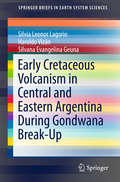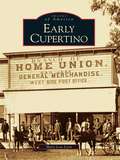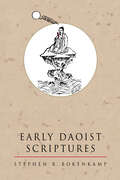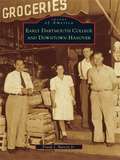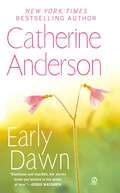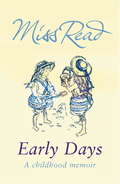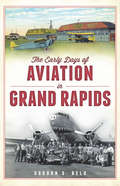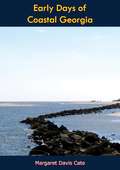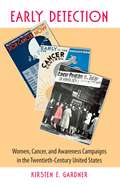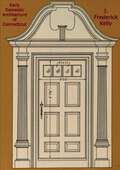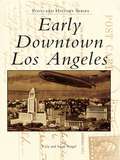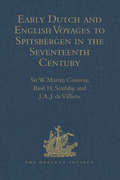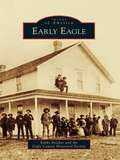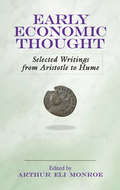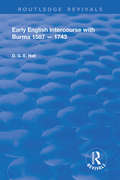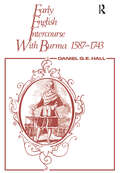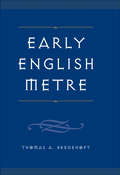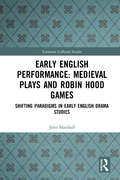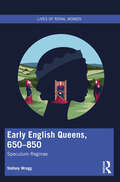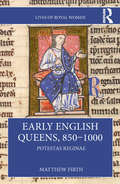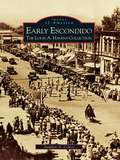- Table View
- List View
Early Cretaceous Volcanism in Central and Eastern Argentina During Gondwana Break-Up
by Silvia Leonor Lagorio Haroldo Vizán Silvana Evangelina GeunaThis book analyzes the Early Cretaceous volcanic processes in Misiones Province and in Sierra Chica de Córdoba (Argentina). The volcanism in Misiones is tholeiitic and belongs to the Parana Magmatic Province (PMP), which extends throughout South America. In contrast, the volcanism in Córdoba is geographically restricted and of alkaline nature, representing a potassic locality peripheral to the PMP. To understand the causes of and geodynamic processes involved in these volcanisms, a new 40Ar /39Ar of 129. 6 ± 1 Ma of a trachyte from Sierra Chica de Córdoba is presented. This dating points out that the volcanism in Sierra Chica de Córdoba slightly postdates PMP lavas. Moreover, complementary geochemical analyses from Misiones Province are presented and compared with those from the whole PMP in order to characterize its source
Early Cupertino
by Mary Lou LyonA priest with Juan Batista de Anza's expedition in 1776 named a wild creek where the group camped after St. Joseph of Cupertino, Italy. A village known as Westside adopted the name in 1904 as it grew up by that stream, now Stevens Creek, near the road that is now De Anza Boulevard. Like its Italian namesake, Cupertino once had wineries, and vineyards striped its foothills and flatlands. Later vast orchards created an annual blizzard of spring blossoms, earning it the name Valley of Heart's Delight. The railroad came to carry those crops to market, and the electric trolley extended to connect Cupertino's first housing tract, Monte Vista. When the postwar building boom came, Cupertino preserved its independence through incorporation, but that bold move would not stop the wave of modernization that would soon roll over the valley.
Early Daoist Scriptures (Daoist Classics #1)
by Stephen R. BokenkampFor centuries Daoism (Taoism) has played a central role in the development of Chinese thought and civilization, yet to this day only a few of its sacred texts have been translated into English. Now Stephen R. Bokenkamp introduces the reader to ancient scriptures never before published in the West, providing a systematic and easily accessible introduction to early Daoism (c. 2nd-6th C.E.). Representative works from each of the principal Daoist traditions comprise the basic structure of the book, with each chapter accompanied by an introduction that places the material within a historical and cultural context. Included are translations of the earliest Daoist commentary to Laozi's Daode jing (Tao Te Ching); historical documents relating the history of the early Daoist church; a petitioning ritual used to free believers from complaints brought against them by the dead; and two complete scriptures, one on individual meditation practice and another designed to rescue humanity from the terrors of hell through recitation of its powerful charms. In addition, Bokenkamp elucidates the connections Daoism holds with other schools of thought, particularly Confucianism and Buddhism.This book provides a much-needed introduction to Daoism for students of religion and is a welcome addition for scholars wishing to explore Daoist sacred literature. It serves as an overview to every aspect of early Daoist tradition and all the seminal practices which have helped shape the religion as it exists today.
Early Dartmouth College and Downtown Hanover (Images of America)
by Frank J. Barrett Jr.The town of Hanover, chartered in 1761, began as a sleepy, idyllic community nestled in the Upper Connecticut River Valley. In 1770, noted Connecticut minister Eleazar Wheelock chose to relocate his school, Dartmouth College, to a virgin wilderness corner of the struggling young township. In spite of hardships, within several years Wheelock and his small college had taken root on the Hanover Plain, joining together with the local community that would come to be known as the "Village at the College." Over the next two centuries, the college and the village would grow together in triumph and tragedy, rich in history and events, to become a special place revered by generations of alumni and residents alike.
Early Dawn (Kendrick/Coulter #10)
by Catherine AndersonA "New York Times"-bestselling author lights up the Old West with an emotionally riveting new historical romance--a tale of love, danger, and redemption, featuring the ancestors of the beloved Coulter family.
Early Days
by Miss ReadThe enchanting childhood memoirs of bestselling author Miss Read.Miss Read's early days were spent with two remarkable grandmothers - one in Lewisham and one in Walton-on-the-Naze. EARLY DAYS is full of childhood memories of an extended family of uncles, aunts and cousins and their houses full of mystery and adventure, where Miss Read spent so much time, living in the shadow of the First World War.At the age of seven, Miss Read moved to the small village of Chelsfield, Kent, into a magical new world - and so began her love of the English countryside which was to have such a strong influence on her career as a writer. Her evocative descriptions of the village school, the joys of exploring the woods and lanes rich in wildlife and of childhood events, from toffee-making to the treat of a lift on the corn-chandler's cart, vividly convey this time as one of the happiest of her life.
Early Days of Aviation in Grand Rapids, The (American Chronicles)
by Gordon G. BeldPerch next to the first man to fly over Grand Rapids and share the spine-tingling thrills of wing-walker Ormer Locklear. Learn how barnstormer "Fish" Hassell led locals to the sky from the shores of Reeds Lake and paved the way for a new air route to Europe. Be there as helicopters and gliders roll off Grand Rapids assembly lines during World War II. Cheer Charles Lindbergh as he steps out of the Spirit of St. Louis at the old Kent County Airport. Ride from Grand Rapids to Detroit on the country's first passenger airline. With journalist Gordon Beld as your pilot, you're in for a spectacular aerial view of Grand Rapids aviation.
Early Days of Coastal Georgia
by Margaret Davis Cate Orrin Sage WightmanDisappearing historic landmarks preserved for posterity…Tabby houses—slave cabins—doorways and cemeteries that recall the history of the early settlers.A story of the living past.Visible evidence of coastal culture. The Military Era and the Plantation Era—its story and heroes…Oglethorpe—the soldiers of Bloody Marsh—faithful Neptune…Along the arc of the Georgia coast there is a chain of sea islands. Of these, Ossabaw, Saint Catherine’s, Sapelo, Saint Simons, Sea Island, Jekyll, and Cumberland are best known as the Golden Isles.Early Days of Coastal Georgia, which was first published in 1955, presents some of their history, illustrated with vintage photos.Beautifully illustrated throughout with photographs by Orrin Sage Wightman.
Early Detection
by Kirsten E. GardnerDispelling the common notion that American women became activists in the fight against female cancer only after the 1970s, Kirsten E. Gardner traces women's cancer education campaigns back to the early twentieth century. Focusing on breast cancer, but using research on cervical, ovarian, and uterine cancers as well, Gardner's examination of films, publications, health fairs, and archival materials shows that women have promoted early cancer detection since the inception of the American Society for the Control of Cancer in 1913. While informing female audiences about cancer risks, these early activists also laid the groundwork for the political advocacy and patient empowerment movements of recent decades.By the 1930s there were 300,000 members of the Women's Field Army working together with women's clubs. They held explicit discussions about the risks, detection, and incidence of cancer and, by mid-century, were offering advice about routine breast self-exams and annual Pap smears. The feminist health movement of the 1970s, Gardner explains, heralded a departure for female involvement in women's health activism. As before, women encouraged early detection, but they simultaneously demanded increased attention to gender and medical research, patient experiences, and causal factors. Our understanding of today's vibrant feminist health movement is enriched by Gardner's work recognizing women's roles in grassroots educational programs throughout the twentieth century and their creation of supportive networks that endure today.
Early Domestic Architecture of Connecticut
by J. Frederick KellyJ. Frederick Kelly’s Early Domestic Architecture of Connecticut is a masterful study of the state’s historic homes, offering an in-depth exploration of the design, craftsmanship, and cultural influences that shaped early American architecture. Drawing from meticulous research and firsthand observation, Kelly provides a comprehensive account of Connecticut’s domestic buildings from the colonial period through the early 19th century.The book examines a variety of architectural styles, from simple one-room cottages to more elaborate Georgian and Federal designs, highlighting the evolution of building techniques and aesthetic preferences over time. Kelly details the materials, layouts, and construction methods used by early settlers, showcasing the ingenuity and resourcefulness required to adapt Old World traditions to the New World environment.Richly illustrated with detailed drawings and photographs, Early Domestic Architecture of Connecticut brings to life the charm and character of these historic structures. Kelly also places these homes in their broader social and historical context, exploring how they reflect the lifestyles, values, and challenges of the people who built and lived in them.This work is an essential resource for historians, architects, preservationists, and anyone interested in early American life. Kelly’s passion for the subject and his meticulous attention to detail make this book not only an authoritative reference but also a tribute to the enduring legacy of Connecticut’s architectural heritage.
Early Domestic Architecture of Connecticut (Dover Architecture)
by J. Frederick KellyBased on personal observation of surviving examples and research into colonial records, this book includes 242 measured diagrams (windows, door frames, construction details, etc.) and 192 photographs of more than 150 homes, 1650 to 1800. Authentic and invaluable. 434 illustrations.
Early Downtown Los Angeles (Postcard History)
by Cory Stargel Sarah StargelGrowing south from the plaza where the city of Los Angeles was founded as a tiny pueblo in 1781, the area now known as downtown L.A. was first developed in the late 1800s as a residential neighborhood, complete with churches and schools. As the population surged at the turn of the 20th century, the downtown area was transformed into a busy business and entertainment center of shops, banks, hotels, and theaters. The explosion of the postcard craze in the early 1900s coincided with this period of downtown's tremendous growth toward a formidable metropolis. This collection of vintage postcards offers a glimpse into the changing city through the 1940s.
Early Dutch and English Voyages to Spitsbergen in the Seventeenth Century: Including Hessel Gerritsz. 'Histoire du pays nommé Spitsberghe,' 1613 and Jacob Segersz. van der Brugge 'Journael of dagh register,' Amsterdam, 1634 (Hakluyt Society, Second Series #11)
by J.A.J. de Villiers Basil H. Soulsby'Early Dutch and English Voyages' translated into English, for the first time, by Basil H. Soulsby, F.S.A., of the British Museum; Segersz's text translated into English, for the first time, by J. A. J. de Villiers, of the British Museum. Edited, with Introduction and Notes, by Sir W. Martin Conway, F.S.A. With affidavits by English merchants and seamen relating to happenings at Spitzbergen in 1618, and two documents telling of events there in 1634-5, taken from Public Record Office, State Papers Domestic. Including a bibliography of Spitzbergen, pp. ix-xiv. This is a new print-on-demand hardback edition of the volume first published in 1904.
Early Eagle
by Eagle County Historical Society Kathy HeicherNestled into a scenic mountain valley at the junction of the Eagle River and Brush Creek, Eagle is a small mountain town that is often overshadowed by its famous ski resort neighbor, Vail. However, this thriving little mountain community claims a rich history of more than 100 years of spunk and fortitude. Eagle's robust character started with the miners who came to the valley in the 1880s seeking gold and silver. Then came the farmers and ranchers, who recognized another type of wealth in the fertile soils and abundant water of the valley. As for that spunk, the townspeople of Eagle were tenacious enough to wage a 20-year war seeking county seat status and progressive enough to keep a small town growing and thriving for over a century.
Early Economic Thought: Selected Writings from Aristotle to Hume
by Arthur Eli MonroeA vital and varied survey of economic theory in the pre-modern era, this well-chosen collection includes extracts from the works of Aristotle, Thomas Aquinas, Antonio Serra, David Hume, and twelve other extraordinary thinkers. Their writings in this volume illustrate the ways in which great thinkers of the past sought to argue for and explain the moral, ethical, monetary, and political dimensions of trade and exchange.Translated and annotated by noted Harvard educator Arthur Eli Monroe, these writings offer invaluable background to students of modern economic theory. Sufficiently varied to reflect the wealth of available material, they include highlights from Aristotle's Politics and Nicomachean Ethics, St. Thomas Aquinas's Summa Theologica, Thomas Mun's England's Treasure by Forraign Trade, and David Hume's Political Discourses. Helpful biographical notes appear at the start of each author's work.
Early Economic Thought: Selections from Economic Literature Prior to Adam Smith
by Arthur Eli MonroeA survey of economic theory in the pre-modern era, this collection includes extracts from the works of Aristotle, Thomas Aquinas, Antonio Serra, and David Hume. Their writings in this volume illustrate the ways in which great thinkers of the past sought to argue for and explain the moral, ethical, monetary, and political dimensions of trade and exchange.
Early Encounters between East Asia and Europe: Telling Failures (Transculturalisms, 1400-1700)
by Michael Keevak Ralf HertelWhile inquiries into early encounters between East Asia and the West have traditionally focused on successful interactions, this collection inquires into the many forms of failure, experienced on all sides, in the period before 1850. Countering a tendency in scholarship to overlook unsuccessful encounters, it starts from the assumption that failures can prove highly illuminating and provide valuable insights into both the specific shapes and limitations of East Asian and Western imaginations of the Other, as well as of the nature of East-West interaction. Interdisciplinary in outlook, this collection brings together the perspectives of sinology, Japanese and Korean studies, historical studies, literary studies, art history, religious studies, and performance studies. The subjects discussed are manifold and range from missionary accounts, travel reports, letters and trade documents to fictional texts as well as material objects (such as tea, chinaware, or nautical instruments) exchanged between East and West. In order to avoid a Eurocentric perspective, the collection balances approaches from the fields of English literature, Spanish studies, Neo-Latin studies, and art history with those of sinology, Japanese studies, and Korean studies. It includes an introduction mapping out the field of failures in early modern encounters between East Asia and Europe, as well as a theoretically minded essay on the lessons of failure and the ethics of cross-cultural understanding.
Early English Composers and the Credo: Emphasis as Interpretation in Sixteenth-Century Music (Routledge Research in Music)
by Wendy J PorterThis book develops an innovative approach for understanding the relationship between music and words in the works of five major composers of the English Renaissance: John Taverner, Christopher Tye, John Sheppard, Thomas Tallis, and William Byrd. Focusing on these composers’ settings of the Latin Credo, the author shows how musical and linguistic emphasis can be used to understand the composers’ theological interpretations of the text. By combining markedness theory with style analysis, this study demonstrates that the composers used their musical skills not only to create beautiful music, but to raise certain elements of the text to the foreground of perception and relegate others to supporting roles, inviting listeners to experience the familiar words of the liturgy in unique ways. Providing new insights into the changing musical and religious world of the sixteenth century, this book is relevant to anyone researching music or religion in early modern England, while offering a flexible and widely adaptable tool for the analysis of musical-textual relationships.
Early English Intercourse with Burma, 1587 – 1743 (Routledge Revivals)
by Daniel G.E. HallFirst published in 1922, this volume constitutes the first attempt yet made to trace the story of English intercourse with Burma from its origins in the 16th century to the middle of the 18th, framed by the period from the opening to the final years of the Syriam factory. Daniel G.E. Hall sought to fill a gap in the literature for students of British enterprise in the East, drawing out the progress of Burma from a commercially unviable backwater to arguably the richest province in resources of the British empire in India.
Early English Intercourse with Burma, 1587-1743 and the Tragedy of Negrais (Routledge Revivals Ser.)
by David George Edward HallFirst Published in 1968. This second edition includes the 'Tragedy of Negrais' as a new appendix. Originally published in 1928 for the University of Rangoon and the sequel three years later- 'Tragedy of Negrais' as a journal for the Burma Research Society. During the Japanese occupation of Burma from 1942 to 1945 unsold copies were lost or destroyed. This volume is a reprint of the original research into the East India Company's records at the India Office. They tell the story of English relations with Burma from the days of Elizabeth I to the beginning of the long break which started in 1762, which started due to the incident in 1759 known as the 'massacre of Negrais' and ended in 1795.
Early English Metre
by Thomas A. BredehoftThomas A. Bredehoft's Early English Metre is a reassessment of the metrical rules for English poetry from Beowulf to Layamon. Bredehoft offers a new account of many of the most puzzling features of Old English poetry - anacrusis, alliteration patterns, rhyme, and hypermetric verses - and further offers a clear account of late Old English verse as it descended from the classical verse as observed in Beowulf. He makes the surprising and controversial discovery that Ælfric?s alliterative works are formally indistinguishable from late verse.Discussing the early Middle English verse-forms of Layamon's Brut, Bredehoft not only demonstrates that they can be understood as developing from late Old English, but that Layamon seems to have known, and quoted from, the poems of the Anglo-Saxon Chronicle. Early English Metre presents a new perspective on early English verse and a new perspective on much of early English literary history. It is an essential addition to the literature on Old and Middle English and will be widely discussed amongst scholars in the field.
Early English Performance: Shifting Paradigms in Early English Drama Studies (Variorum Collected Studies)
by John MarshallCovering a period of nearly 40 years’ work by the author this collection of essays in the Shifting Paradigms in Early English Drama Studies series brings the perspective of a Drama academic and practitioner of early English plays to the understanding of how medieval plays and Robin Hood games of the fifteenth and sixteenth centuries were performed. It explores why, where, when, and how the plays happened, who took part, and who were the audiences. The insights are informed by a combination of research and the public presentation of surviving texts. The research included in the volume unites the early English experiences of religious and secular performance. This recognition challenges the dominant critical distinction of the past between the two and the consequent privileging of biblical and moral plays over secular entertainments. What further binds, rather than separates, the two is that the destination of funds raised by the different activities maintained the civic and parochial needs of the institutions upon which the people depended. This collection redefines the inclusive nature and common interests of the purposes that lay behind generically different undertakings. They shared an extraordinary investment of human and financial resources in the anticipation of a profit that was pious and practical.
Early English Queens, 650–850: Speculum Reginae (Lives of Royal Women)
by Stefany WraggThis book offers the first dedicated and comprehensive examination of the lives of nearly thirty women known to occupy the office of queen in the English kingdoms between 650 and 850. The queens of early England are often shadowy figures in the historical record, beset by numerous issues which have largely confined them to the margins of history. Through careful analysis, the volume presents a ground-breaking appraisal of the role of queens in early England, and how their actions and identities shaped their practice of queenship. Organised thematically, it offers an overview of queens in many different roles, such as agents of Christianity, mothers, and peace-weavers. From high profile queens such as Æthelthryth of Ely and Cynethryth of Mercia, to the shadowy Leofrun of East Anglia and the nameless queen of Anna of East Anglia, the book engages with sources to advance fuller narratives about even the most obscure queens of the era. Aided by resources such as genealogical tables, Early English Queens, 650–850 is an ideal resource for students and scholars at all levels, as well general readers, interested in the lives of queens and early English history.
Early English Queens, 850–1000: Potestas Reginae (Lives of Royal Women)
by Matthew FirthThis book offers a comprehensive, biography-led examination of queenship in England between 850 and 1000, tracing the development of the queen’s role from bed companion to institutional office.The period 850–1000 is critical to the development of English queenship. In the aftermath of viking invasion, the kings of Wessex expanded their hegemony over neighbouring regions, gradually establishing themselves as the kings of England. Parallel to this broad narrative of political change is the lesser-known story, told in this book, of the royal women who took part in it. The lives of three remarkable women – Æthelflæd, Lady of the Mercians, and the West Saxon consorts Eadgifu and Ælfthryth – are central to the story, here retold through the careful analysis and reappraisal of source documents. These biographies set the stage for detailed study of the agency and advocacy of all women who held queenly office in England between 850 and 1000, as well as their legacies and reception by later generations.Early English Queens, 850–1000 gives important insights into the role women played in the first 150 years of the West Saxon dynasty, offering a compelling narrative that will appeal to students and scholars of early medieval England and royal studies.
Early Escondido: The Louis A. Havens Collection
by Stephen A. CoveyLouis A. Havens was a Southern California pioneer businessman, storyteller, and artist who brought the community of Escondido together via his camera. He was the first successful photographer in the thriving north San Diego County agricultural city, incorporated in 1888. Prior to his arrival, the occasional photographer might seasonally visit Escondido or attempt to set up shop, realizing little success. Havens's timing in his arrival, combined with his skillful eye, ensured his success from 1911 to 1944. His collection documents Escondido's early residents, architecture, events, and landscapes, and it now persists as a historic record of past events, culture, and development of the fourth largest city in San Diego County.
